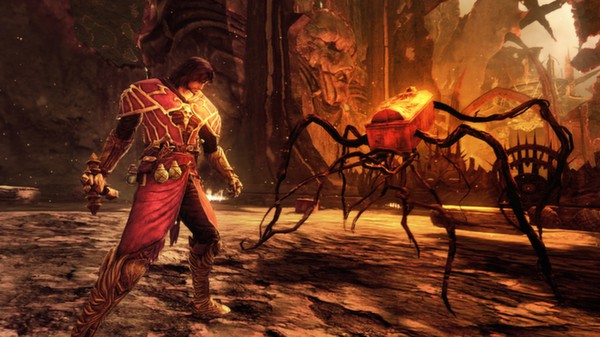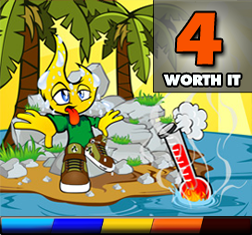Back in 2010, the long forgotten Castlevania series emerged from the shadows and onto Xbox 360 and PS3 consoles amongst a plethora of critically acclaimed sequels. While Lords of Shadow, Konami’s second attempt at translating the 2D action-platforming legend into a three dimensional epic was a hit for both Castlevania veterans and novices, there were areas where the game failed to shine and the two aging platforms did not do it justice. Enter Castlevania: Lords of Shadow  Ultimate Edition for PC, a technically advanced and long awaited port for the other half of the gaming market, featuring both expansions, Reverie and Resurrection. For those of you who have already played the game on consoles and are after an evaluation of the port and not a review of the game, I’ll go over this on the sixth paragraph.
Ultimate Edition for PC, a technically advanced and long awaited port for the other half of the gaming market, featuring both expansions, Reverie and Resurrection. For those of you who have already played the game on consoles and are after an evaluation of the port and not a review of the game, I’ll go over this on the sixth paragraph.
For those who never got the chance to play Lords of Shadow on consoles or are new to the series, Konami has rewritten the Castlevania mythos to suit a broader audience while retaining the elements the more hardcore fans loved most about it. The player assumes the role of Gabriel Belmont, a member of the knightly order The Brotherhood of Light, on a holy mission to rid the world of an ever growing evil and avenge the death of his beloved wife. The eight chapter story spans across a vast array of different locations, each one with a high emphasis on dark fantasy which blends well with the apocalyptic tones of the narrative. The story’s main focus is Gabriel dealing with his tragic loss, resulting in the player empathising with the lead character on several occasions. While sharing the power and badass dress sense of a vampire hunter, this towering hulk of a warrior is actually quite a softy on the inside, and with the captivating voice talents of Robert Carlyle, he makes one of the most developed and endearing characters in a Castlevania title. Throughout the adventure, Gabriel will come across a cast of supernatural creatures and characters, werewolves and  vampires aplenty, serving a treat for those who appreciate the series’ unique takes on Hammer Horror-esque monsters. Characters such as the guardian of the lake, Pan, and the mute telepath, Claudia, while serving as guides, create an aura of wonder and mystery, where the three titular antagonists have each their own unique methods of imparting fear into the player.
vampires aplenty, serving a treat for those who appreciate the series’ unique takes on Hammer Horror-esque monsters. Characters such as the guardian of the lake, Pan, and the mute telepath, Claudia, while serving as guides, create an aura of wonder and mystery, where the three titular antagonists have each their own unique methods of imparting fear into the player.
When it comes to gameplay, the lack of originality is quite obvious in Lords of Shadow, making the story and characters the much stronger element of the game. However, while the combat does have very strong similarities to PS3 title God of War, with its predominant use of whips and quick time events; it still holds its own as a solid, enjoyable hack and slash experience. The main protagonist possesses a Combat Cross, which transforms into a powerful chain whip weapon, providing as the base of the fast and fluid melee combat. Different weapons are added early into the game, such as the throwing daggers, which are useful for picking off the odd minion at the push of a button. The player will find other new weapons in chests which appear impossible to get to, but in true Castlevania fashion, these will become accessible after obtaining a certain relic or power. While not fully emulating the exploration component of the more open-world Castlevania games, it serves as a good addition for collectors and completionists, as well as an optional aid for less practised players, who just need that extra help fighting that one enemy. There  is also a Light and Shadow magic system, which gives the player access to defensive and offensive spell. This encourages the player to devise strategies, especially in bigger fights, making use of protection and healing magic in conjunction with damage dealing ones. Unlockable spells and combos for weapons can be purchased using experience points, gained primarily by killing enemies and kindly rewarded to players for solving puzzles without asking for the solution.
is also a Light and Shadow magic system, which gives the player access to defensive and offensive spell. This encourages the player to devise strategies, especially in bigger fights, making use of protection and healing magic in conjunction with damage dealing ones. Unlockable spells and combos for weapons can be purchased using experience points, gained primarily by killing enemies and kindly rewarded to players for solving puzzles without asking for the solution.
Right off the bat, Gabriel is forced into a fight with a party Lycans (werewolves) who are raiding a village. Accompanied by onscreen prompts, it isn’t long until the player finds themself fighting a giant wolf and gloriously impaling it with a large stake. While a fair amount of this fight is made up of quick time events, it makes the battle that more visually exciting and increases the level of concentration required. Not only does it accomplish this much with quick time events but Lords of Shadow executes them without distracting the player too much from the actual fight. The more dominant use of the quick time event is for the titan battles, which feature humongous elemental golems which the player has to climb up using the games essential platforming elements. Taking inspiration from Shadow of the Colossus, these encounters are outstanding to watch, but at the steep cost of the freedom and strategy the normal boss battles have to offer. One major issue with combat is the fixed camera angles.  While not always a nuisance, it will sometimes require you to reposition yourself in a boss fight just to tell where he is, and can also result in some faster enemies pouncing on where in any other game you would have seen them coming.
While not always a nuisance, it will sometimes require you to reposition yourself in a boss fight just to tell where he is, and can also result in some faster enemies pouncing on where in any other game you would have seen them coming.
I could name many Castlevania titles that didn’t have good gameplay, but I couldn’t give you a Castlevania game that didn’t have a good soundtrack. Lords of Shadow is no exception, though against its heritage, it’s more of a fantasy epic style score than the gothic tracks of previous titles. This sounds bad for those like me who expected modernised versions of “Vampire Killer” or “Battle of the Holy” (Castlevania: The Adventure, like I said, bad game, good music), but after playing a few levels with amateur arrangements in the background, I personally couldn’t imagine those rock heavy themes ever working as orchestral pieces or otherwise. Accompanying the soundtrack is an amazing cast of voice talent. As mentioned earlier, Robert Carlyle does an amazing job conveying the humanity of the main protagonist. The immortal Patrick Stewart lends his voice to narrator and bewildering companion, Zobeck, whose endearing delivery is very easy to listen to on the loading screens.
 One of the biggest issues with the console port was that it suffered with extremely poor frame rates. I myself stopped playing soon after the second chapter as the persisting drops were severely ruining the immersion. The PC seems to have solved this problem, providing a smooth experience for most mid-range systems. My GTX 680 was having no trouble handling the game on Max Settings at a steady 60 FPS, and being more a GPU intensive game, it’ll have no problems running on a dual-core machine. As well as this, the game looks far better than its console releases. It’s evident a lot of time and effort has been put into making it. Worth mentioning is the implementation of keyboard keys into menu and game prompts, a feature lacking in a lot of poorly made ports. Also, while this may be nitpicking, the FMV cutscenes appear to be the same as those used on the console versions, with low resolution and frame rate. The dissonance between the low quality cutscenes and the hi-res gameplay can be quite jarring, though fortunately the FMVs in this game are scarce.
One of the biggest issues with the console port was that it suffered with extremely poor frame rates. I myself stopped playing soon after the second chapter as the persisting drops were severely ruining the immersion. The PC seems to have solved this problem, providing a smooth experience for most mid-range systems. My GTX 680 was having no trouble handling the game on Max Settings at a steady 60 FPS, and being more a GPU intensive game, it’ll have no problems running on a dual-core machine. As well as this, the game looks far better than its console releases. It’s evident a lot of time and effort has been put into making it. Worth mentioning is the implementation of keyboard keys into menu and game prompts, a feature lacking in a lot of poorly made ports. Also, while this may be nitpicking, the FMV cutscenes appear to be the same as those used on the console versions, with low resolution and frame rate. The dissonance between the low quality cutscenes and the hi-res gameplay can be quite jarring, though fortunately the FMVs in this game are scarce.
Castlevania: Lords of Shadow Ultimate Edition provides a memorable experience for both fans of the series and those looking for a good story. While combat is barely original, it promises to be flawless and rivals more popular titles. And for a port, the graphics are outstanding and could be compared with the visual quality of more recent releases. With its two DLCs and generous RRP of £19.99, it’s definitely worth it for PC gamers who have been missing out on this series reboot. But those who aren’t particularly bothered by narrative and are in it for the gameplay may as well wait a bit longer for the sequel.
Disclaimer:All scores given within our reviews are based on the artist’s personal opinion; this should in no way impede your decision to purchase the game.









You must be logged in to post a comment.